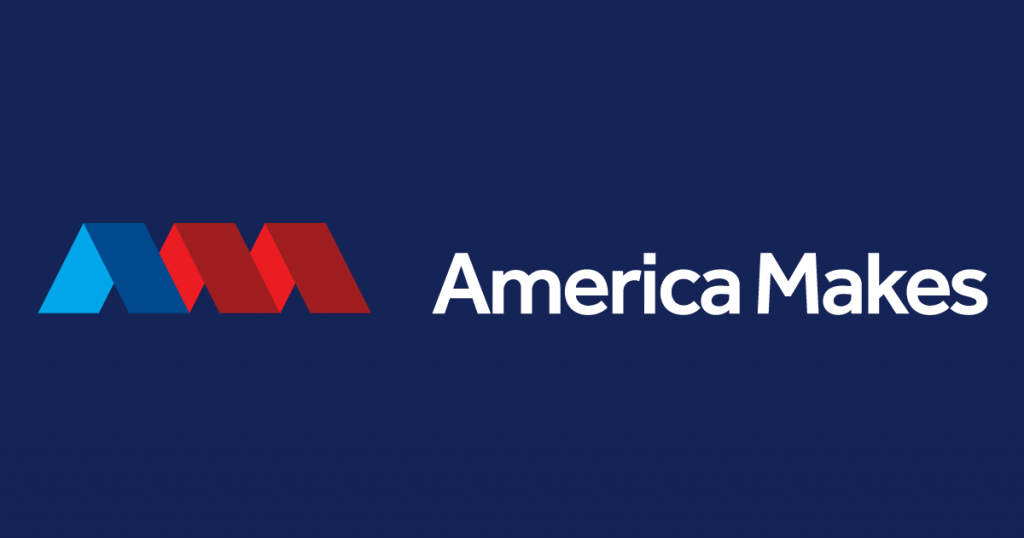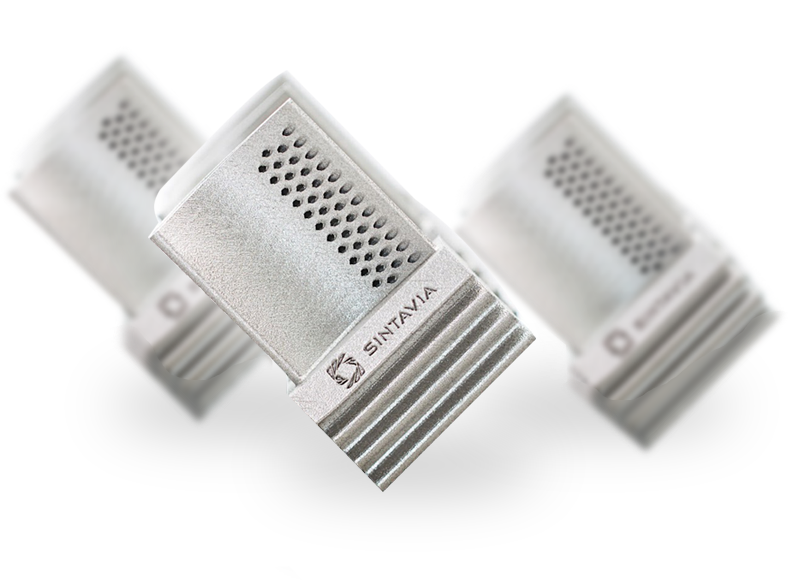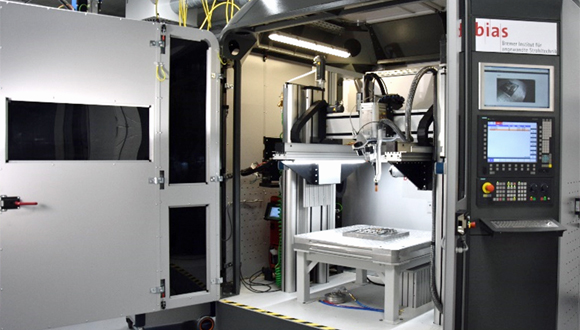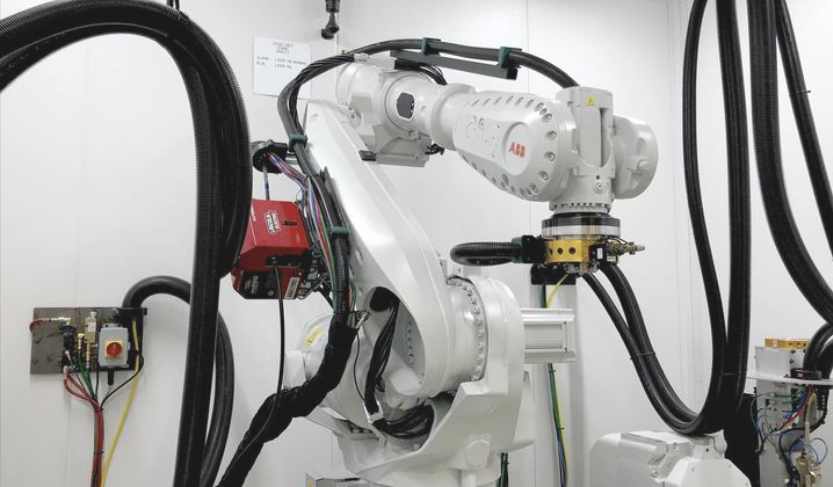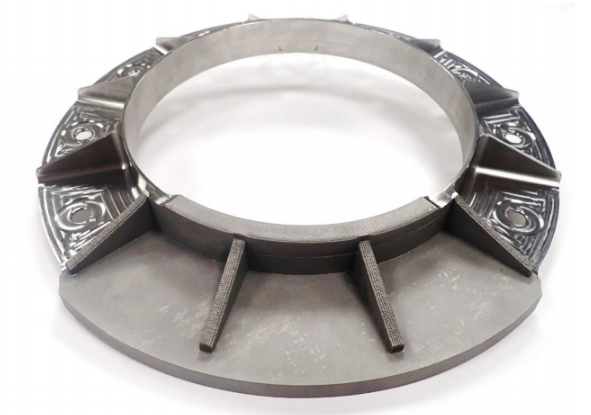ARFL, Boeing, Thermwood apply Large Scale Additive Manufacturing to autoclave tools
3D Printing Industry Experts Interview: Jeffrey DeGrange of Impossible Objects
Jeffery DeGrange is the current Chief Commercial Officer at Impossible Objects. Before this, he was Vice President of Business and Application Development for Stratasys. He has spent twenty years at The Boeing Company where he led innovative material and process research and development in the areas of additive manufacturing, reverse engineering and advanced manufacturing. He holds various patents for the direct manufacturing of end-use parts and multiple functional tooling used in military and commercial aircraft programs. While at Boeing, he was a key principle to certify and qualify first ever additive manufacturing material and processes for flight hardware used on the F/A-18 super hornet and the 787 Dreamliner production aircraft programs.
Give us some background on your experience and how it has gotten you this far?
I started with Boeing in 1995. I was working with the Boeing additive team to work on parts that would go on aircrafts. This started in 1999. I feel in love with the field. Then I left Boeing to work for Stratsys to be the VP. I was focusing on the technology for manufacturing purposes. I worked with Stratsys and various companies for 7 years. Then I came and worked with Impossible Objects in 2017. The technology was very interesting and appealing. The parts they were making was so much stronger and lighter. The technology could be scaled up easily as well.

Explain a bit about your day to day at impossible objects?
It has different legs to the stool. Sometimes we are talking to various material suppliers and doing material assessment. We are also talking to companies and how the technology can be used for their purposes. There also is a need for documentation. We have marketing, technical, and business writing that needs to be done. The last leg is introducing and talking to prospective clients.
How are barriers broken for skills on higher level machines?
Society of manufacturing engineers. America Makes is trying to build the educational courses for someone to be a technician. We are building out courses that are needed as well as hands on initiatives. With additive a lot of costs are indeed saved. We can use these saved costs to reinvest in our workers and the community around us.
What are the key verticals that an organization has to consider in terms of transitioning towards an additive manufacturing economy?
I think the cost of equipment and material are so important. Aerospace organizations are at the forefront. The medical industry is then next to consider. Particularly clinical trials are happening quicker with these techniques than traditional techniques. Slower adoption is occurring, but it is happening. I recently became an adviser for the Mayo Clinic in terms of printing and prototyping in terms of surgery.
How important is policy and social infrastructure in terms of the future additive manufacturing economy?
I think that there are some things to be done there in order to streamline the acceptance of these devices. We want to make sure in cases like the medical industry that we have FDA clearance. There needs to be a lot of smart people at a table to streamline certifications in that sense. It is important to deal with this in terms of the FAA and the Internal Department of Defense.
Oerlikon opens $55 million additive manufacturing facility in North Carolina
3D printed molds are helping NASA to insulate its newest deep space rocket
3D printing industry responds to proposed extension of BIS U.S. export controls
Top 10 3D Printing Aerospace Stories from 2018
3D printing has played an important role in many industries over the past year, such as medical, education, and aerospace. It would take a very long time to list all of the amazing news in aerospace 3D printing in 2018, which is why we’ve chosen our top 10 stories for you about 3D printing in the aerospace industry and put them all in a single article.
Sintavia Received Approval to 3D Print Production Parts for Honeywell Aerospace
Tier One metal 3D printer manufacturer Sintavia LLC, headquartered in Florida, announced in January that it is the first company to receive internal approval to 3D print flightworthy production parts, using a powder bed fusion process, for OEM Honeywell Aerospace. Sintavia’s exciting approval covers all of Honeywell’s programs.
Boeing and Oerlikon Developing Standard Processes
Boeing, the world’s largest aerospace company, signed a five-year collaboration agreement with Swiss technology and engineering group Oerlikon to develop standard processes and materials for metal 3D printing. Together, the two companies will use the data resulting from their agreement to support the creation of standard titanium 3D printing processes, in addition to the qualification of AM suppliers that will produce metallic components through a variety of different materials and machines. Their research will focus first on industrializing titanium powder bed fusion, as well as making sure that any parts made with the process will meet the necessary flight requirements of both the FAA and the Department of Defense.
FITNIK Launched Operations in Russia
In 2017, FIT AG, a German provider of rapid prototyping and additive design and manufacturing (ADM) services, began working with Russian research and engineering company NIK Ltd. to open up the country’s market for aerospace additive manufacturing. FIT and NIK started a new joint venture company, dubbed FITNIK, which combines the best of what both companies offer. In the winter of 2018, FITNIK finally launched its operations in the strategic location of Zhukovsky, which is an important aircraft R&D center.
New Polymer 3D Printing Standards for Aerospace Industry
The National Institute for Aviation Research (NIAR) at Wichita State University (WSU), which is the country’s largest university aviation R&D institution, announced that it would be helping to create new technical standard documents for polymer 3D printing in the aerospace industry, together with the Polymer Additive Manufacturing (AMS AM-P) Subcommittee of global engineering organization SAE International. These new technical standard documents are supporting the industry’s interest in qualifying 3D printed polymer parts, as well as providing quality assurance provisions and technical requirements for the material feedstock characterization and FDM process that will be used to 3D print high-quality aerospace parts with Stratasys ULTEM 9085 and ULTEM 1010.
Premium AEROTEC Acquired APWORKS
Metal 3D printing expert and Airbus subsidiary APWORKS announced in April that it had been acquired as a subsidiary by aerostructures supplier Premium AEROTEC. Premium AEROTEC will be the sole shareholder, with APWORKS maintaining its own market presence as an independent company. Combining the two companies gave clients access to 11 production units and a wide variety of materials.
Gefertec’s Wire-Feed 3D Printing Developed for Aerospace
Gefertec, which uses wire as the feedstock for its patented 3DMP technology, worked with the Bremer Institut für Angewandte Strahltechnik GmbH (BIAS) to qualify its wire-feed 3D printing method to produce large structural aerospace components. The research took place as part of collaborative project REGIS, which includes several different partners from the aerospace industry, other research institutions, and machine manufacturers. Germany’s Federal Ministry for Economic Affairs and Energy funded the project, which investigated the influence of shielding gas content and heat input on the mechanical properties of titanium and aluminium components.
Research Into Embedded QR Codes for Aerospace 3D Printing
It’s been predicted that by 2021, 75% of new commercial and military aircraft will contain 3D printed parts, so it’s vitally important to find a way to ensure that 3D printed components are genuine, and not counterfeit. A group of researchers from the NYU Tandon School of Engineering came up with a way to protect part integrity by converting QR codes, bar codes, and other passive tags into 3D features that are hidden inside 3D printed objects. The researchers explained in a paper how they were able to embed the codes in a way that they would neither compromise the integrity of the 3D printed object or be obvious to any counterfeiters attempting to reverse engineer the part.
Lockheed Martin Received Contract for Developing Aerospace 3D Printing
Aerospace company Lockheed Martin, the world’s largest defense contractor, was granted a $5.8 million contract with the Office of Naval Research to help further develop 3D printing for the aerospace industry. Together, the two will investigate the use of artificial intelligence in training robots to independently oversee the 3D printing of complex aerospace components.
BeAM And PFW Aerospace Qualified 3D Printed Aerospace Component
BeAM, well-known for its Directed Energy Deposition (DED) technology, announced a new partnership with German company PFW Aerospace, which supplies systems and components for all civilian Airbus models and the Boeing 737 Dreamliner. Together, the two worked to qualify a 3D printed aerospace component, made out of the Ti6Al4V alloy, for a large civil passenger aircraft, in addition to industrializing BeAM’s DED process to manufacture series components and testing the applicability of the method to machined titanium components and complex welding designs.
Researchers Qualified 3D Printed Aerospace Brackets
Speaking of parts qualification, a team of researchers completed a feasibility study of the Thermoelastic Stress Analysis (TSA) on a titanium alloy space bracket made with Electron Beam Melting (EBM) 3D printing, in order to ensure that its mechanical behavior and other qualities were acceptable. The researchers developed a methodology, which was implemented on a titanium based-alloy satellite bracket.
Discuss these stories and other 3D printing topics at 3DPrintBoard.com or share your thoughts below.
Watch: Thermwood 3D prints 12 foot aircraft tool for Boeing 777X
Thermwood and Boeing Make Large 3.6 Meter 3D Printed 777X Program Tooling Part
Thermwood and Boeing have announced that they’ve made a large 3D printed composite part for Boeing’s 777X program. The Thermwood’s LSAM technology was used to make a 20% carbon fiber reinforced ABS part. The part is a “12-foot-long R&D tool.” This demonstrates the possible applications of polymer 3D printing for large parts for aerospace, albeit in experimental tooling.

Boeing’s 777X program will create Boeing’s next-generation long-range wide-body airliners. The 777-8 and 777-9 aircraft will be the mainstays of many point to point long distance fleets of global carriers. The 777-9 will carry over 400 passengers over 13,000 kilometers. Having maxed out composites on its 787 aircraft Boeing is looking to bring its expertise in composite materials to these twin-aisle airliners. With folding wing tips and expected inefficiencies, they will double down on Boeing’s strategy to focus on connecting disparate dots on the earth together with direct flights. This in contrast to the Airbus strategy of efficient short-haul airliners combined with hub and spoke with large A 380’s flying between big cities. Composites were crucial to Boeing’s development of the 787. Boeing was also a very early (think 1995) pioneer in using various 3D printing technologies on many military and civilian platforms. To see these two technologies intertwine in LSAM feels very logical indeed.
Thermwoos’s Large Scale Additive Manufacturing machine and its Vertical Layer Print (VLP) 3D printing technology can make large composite parts. With LSAM a wheel presses down a layer as it is being printed on the previous layer. Print speed depends on the cooling on the polymer itself and the printed part is either printed on a scaffold. The company calls this a “bead board” because the droplets of plastic “beads” are glued to it. LSAM is a very interesting approach that gives us very large but rather rough parts with a good amount of control over layer adhesion.

This particular printed 4 meter part was made in one production run and was intended to save Boeing time. The part also saved on assembly cost. Boeing’s Interiors Responsibility Center (IRC) facility in Everett, Washington now has a Thermwood LSAM machine that it can now use to make parts like this. These kinds of parts could aid in hand layup or assembly operations of existing parts. The high stiffness of the ABS parts should be helpful in that area. One of the amazing things is that with LSAM Thermwood prints ABS at room temperature and through the scaffold and pressing the layer down seems to have little problems with warping. Printing at room temperature would seem to limit the technology somewhat. It would seem to be difficult for the company to use materials such as PEI which are used for end use in aerospace because of the temperatures used. Jason Susnjara of Thermwood told us however that, “We do print other materials such as Ultem, PPS, PSU and PESU.” This is a great step in making large-scale tooling and parts for industry.
A further step where large cabin parts would themselves be made with 3D printing would be even more exciting. For that, a flame retardant material that is certified for civilian airliners will have to be used. A material such as PEEK, PEI or PEKK could perhaps fulfill that purpose but it is unclear at the moment how we would get the heated chamber thermal control to make parts this size out of those materials. Or if LSAM could be adapted to print the right grades of these materials. Simultaneously Boeing would want to instead of carbon fiber which is nasty to make for its employees and is impossible to recycle use a more environmentally friendly material that could be recycled. A hemp PEKK, silk PEI or flax PEEK may sound like a perfectly silly idea but something like them would let Boeing continue to win in 3D printing and composites.
3D Printing News Briefs: September 27, 2018
We’re starting with some news from the ongoing TCT Show in today’s 3D Printing News Briefs, and then moving on to webcasts and YouTube videos, finishing with an update on the upcoming Viaggio a Shamballa event by WASP. At the TCT Show, AMFG has unveiled its new Supplier Integration Network. An applications engineer from Fisher Unitech conducted a webcast about using Lean Six Sigma Manufacturing to optimize additive manufacturing, a Technical University of Denmark professor talked about the possibilities of topology optimization for 3D printing, and a Boeing engineer discussed 3D printing in the aeronautics industry. Finally, we’re getting ever closer to the date that WASP will publicly present its Crane construction 3D printer, and the village it’s building, in Massa Lombarda, Italy.
AMFG Introducing Supplier Integration Network at TCT Show
 At the TCT Show, which continues in Birmingham through this Thursday, AM automation software provider AMFG is unveiling the newest feature in its software platform: the Supplier Integration Network, which lets manufacturers coordinate their AM supply chain network and automate production. With the Supplier Integration Network, manufacturers can outsource production or post-processing to their suppliers, and suppliers and service bureaus can use it to give OEMs easier access to their services. The company believes that this latest feature will make its portfolio more attractive to manufacturers looking to invest in 3D printing.
At the TCT Show, which continues in Birmingham through this Thursday, AM automation software provider AMFG is unveiling the newest feature in its software platform: the Supplier Integration Network, which lets manufacturers coordinate their AM supply chain network and automate production. With the Supplier Integration Network, manufacturers can outsource production or post-processing to their suppliers, and suppliers and service bureaus can use it to give OEMs easier access to their services. The company believes that this latest feature will make its portfolio more attractive to manufacturers looking to invest in 3D printing.
“Manufacturers are looking to scale their additive production effectively and we’re committed to giving them the software infrastructure to do so. Facilitating greater connectivity between all players along the supply chain, through automation, is a large part of this,” said Keyvan Karimi, CEO of AMFG. “Our vision with the Supplier Integration Network is also to help companies achieve truly distributed manufacturing by providing a greater level of connectivity along the supply chain through our platform. Of course, the Supplier Integration Network feature is designed to be used in conjunction with our other AM solutions, from project management to production planning and more.”
To see this new automation platform for yourself, visit AMFG at Stand J42 at the TCT Show.
Fisher Unitech Webcast: Optimizing Additive with Lean Six Sigma Manufacturing
 3D printer and 3D product development software provider Fisher Unitech, a distributor of MakerBot and Nano Dimension 3D printers, is on a mission to advance manufacturing in America by supporting, delivering, and training customers on the best software and manufacturing solutions. Recently, Gerald Matarazzo, a 3D Printing Application Engineer with the company, as well as a Certified Lean Six Sigma Green Belt, recorded a webcast all about using the Lean Six Sigma methodology to optimize additive manufacturing. During the webcast, Matarazzo introduces viewers to some Lean Six Sigma best practices, tips, tools, and tricks to help 3D printing companies stop getting hung up on costly delays.
3D printer and 3D product development software provider Fisher Unitech, a distributor of MakerBot and Nano Dimension 3D printers, is on a mission to advance manufacturing in America by supporting, delivering, and training customers on the best software and manufacturing solutions. Recently, Gerald Matarazzo, a 3D Printing Application Engineer with the company, as well as a Certified Lean Six Sigma Green Belt, recorded a webcast all about using the Lean Six Sigma methodology to optimize additive manufacturing. During the webcast, Matarazzo introduces viewers to some Lean Six Sigma best practices, tips, tools, and tricks to help 3D printing companies stop getting hung up on costly delays.
“I want to be very clear – this presentation is meant for managers, not analysts,” Matarazzo explains in the webcast. “What that basically means is, once again, we’re going to be going over management tools, optimization, and tips and tricks on how to better manage a team or better manage a fleet of machines.”
Watch the 30-minute webcast below to learn more:
Topology Optimization Possibilities for 3D Printing
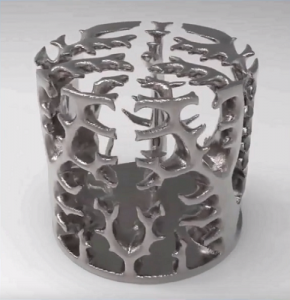 In a new YouTube video posted by Simuleon, a reseller of Dassault Systèmes SIMULIA products, you can see an interview with Ole Sigmund, a professor at the Technical University of Denmark (DTU) and the keynote speaker at Dassault’s Additive Manufacturing Symposium, which opened this year’s popular Science in the Age of Experience event. Sigmund is one of the inventors of topology optimization, a mathematical approach that optimizes material layout within a given design space. It allows designers to take advantage of the geometrical freedoms possible through 3D printing. In the video, Sigmund discusses the possibilities of topology optimization, and infill technologies, for additive manufacturing.
In a new YouTube video posted by Simuleon, a reseller of Dassault Systèmes SIMULIA products, you can see an interview with Ole Sigmund, a professor at the Technical University of Denmark (DTU) and the keynote speaker at Dassault’s Additive Manufacturing Symposium, which opened this year’s popular Science in the Age of Experience event. Sigmund is one of the inventors of topology optimization, a mathematical approach that optimizes material layout within a given design space. It allows designers to take advantage of the geometrical freedoms possible through 3D printing. In the video, Sigmund discusses the possibilities of topology optimization, and infill technologies, for additive manufacturing.
“So essentially additive manufacturing offers ultimate freedom for manufacturing but they don’t know how to come up with these optimal parts. And on the other hand, topology optimization uses this ultimate freedom to come up with parts that are optimized for specific load cases and extreme situations. And so topology optimization provides the designs to additive manufacturing and additive manufacturing makes it possible to realize the designs coming from topology optimization, so that is an ideal marriage.”
3D Printing in the Aeronautics Industry
 At this summer’s EAA Oshkosh AirVenture aviation event in Wisconsin, Boeing structures researcher Bernardo Malfitano delivered an hour-long talk about the use of 3D printing in the aeronautics industry. Understanding Airplanes recently published the YouTube video of the talk, along with the presentation slides. The Boeing researcher’s talk discussed the history of aviation companies using common 3D printing methods like SLA and FFF, how the the technology is currently used in the aerospace industry, and the ongoing research that will introduce even more applications in the future, such as surface smoothing and fatigue testing. The presentation also shows dozens of 3D printed parts that are currently in use on aircraft by companies and organizations like Boeing, Airbus, Lockheed Martin, and NASA.
At this summer’s EAA Oshkosh AirVenture aviation event in Wisconsin, Boeing structures researcher Bernardo Malfitano delivered an hour-long talk about the use of 3D printing in the aeronautics industry. Understanding Airplanes recently published the YouTube video of the talk, along with the presentation slides. The Boeing researcher’s talk discussed the history of aviation companies using common 3D printing methods like SLA and FFF, how the the technology is currently used in the aerospace industry, and the ongoing research that will introduce even more applications in the future, such as surface smoothing and fatigue testing. The presentation also shows dozens of 3D printed parts that are currently in use on aircraft by companies and organizations like Boeing, Airbus, Lockheed Martin, and NASA.
“I should probably specify that this isn’t really 3D printing for home builders, because I’m mostly gonna talk about more advanced technologies and more expensive 3D printers,” Malfitano said at the beginning of his talk. “I’m gonna talk about 3D printers that can print metal parts that cost millions of dollars.”
You can watch the whole presentation in the video below:
Viaggio a Shamballa Event by WASP Coming Soon
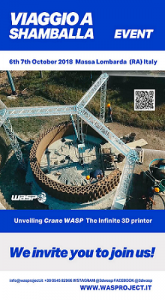 The versatile Italian company WASP, or the World’s Advanced Saving Project, has spent the last two years developing a new large-scale construction 3D printer called the Crane, a modular system consisting of multiple print bodies that’s evolved from the BigDelta 12M. In less than two weeks, WASP will be presenting the Crane to the public in Massa Lombarda, which is where the village of Shamballa is being 3D printed. On October 6th and 7th, a program will be held surrounding the introduction of the WASP Crane 3D printer and the Gaia Module 3D printed earth house. The conference “A call to save the world” will open the event, focusing on future 3D printing construction developments and proposing themes for reflection on both design strategy and the technology’s potential in architecture.
The versatile Italian company WASP, or the World’s Advanced Saving Project, has spent the last two years developing a new large-scale construction 3D printer called the Crane, a modular system consisting of multiple print bodies that’s evolved from the BigDelta 12M. In less than two weeks, WASP will be presenting the Crane to the public in Massa Lombarda, which is where the village of Shamballa is being 3D printed. On October 6th and 7th, a program will be held surrounding the introduction of the WASP Crane 3D printer and the Gaia Module 3D printed earth house. The conference “A call to save the world” will open the event, focusing on future 3D printing construction developments and proposing themes for reflection on both design strategy and the technology’s potential in architecture.
“Knowledge applied to common good. If we use digital manufacturing techniques to respond to the basic human needs, we start up a real hope and this will be the guiding thread of “A call to save the world”. A home is undoubtedly a primary need and WASP’s mission has always been to develop processes and tools to allow men, wherever they are, to build 3D printed houses with material found on site and at a cost that tends to zero,” WASP wrote in a press release.
“The WASP call is addressed to all those who want to collaborate and spread the new construction techniques, with the final aim to create a better world. Representatives of international organizations involved in architectural research, such as IaaC (Institute Advanced Architecture Catalunya, ES), XtreeE (FR), D-Shape (IT), Emerging Objects (USA), will take part in the meeting.”
Check out the complete program here.
Discuss these stories and other 3D printing topics at 3DPrintBoard.com or share your thoughts below.



